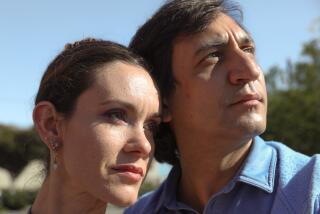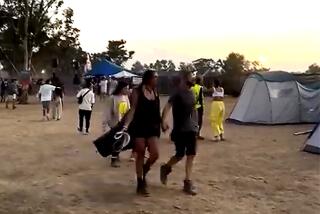Los Angeles Ballet delivers a sizzling ‘Evangelist’
Adding a dose of fire and brimstone to its expanding repertory on Friday, Los Angeles Ballet mounted a scorching rendition of “The Evangelist” at UCLA’s Freud Playhouse in the first of five Southland performances at four venues.
Choreographed in 1992 by Lar Lubovitch for Thordal Christensen and Colleen Neary, then dancers with Pacific Northwest Ballet and now artistic directors of the homegrown troupe, the mini-drama had not been seen since. A pity, as this tiny jewel, inspired by magnetic preacher Aimee Semple McPherson, has lost none of its raw power and passion.
Set to music by Charles Ives, the dance, one of four on Los Angeles Ballet’s final program of its second season, featured Melissa Barak and Peter Snow (alternating with Kelly Ann Sloan and Andrew Brader), as evangelist and penitent, respectively. Barak, whether chest-thumping or beseeching with outstretched arms, brought ferocious life to the 1920s character, creating an electrifying chemistry with her cringing, quaking convert.
In a nod to another high priestess -- Martha Graham -- the work never veered into overly sentimental territory but showcased Barak as a high-kicking, leaping vessel for salvation, with Snow, her vulnerable kinetic charge, ultimately consoled, his sins forgiven.
Redemption, sadly, was not found in Jennifer Backhaus’ world premiere, “she said/he said.” This overly long work, at 23 minutes, set to a minimalist score (on tape) by rising star Nico Muhly, made use of 21 dancers but brought little to the table. First seen with their backs to the audience, the leotard-clad performers, when not weaving about in random line formations, served as automaton-like leapers and leaners.
Various couples took turns assaying push-pull moves, including Aubrey Morgan and Damien Johnson and Sergey Kheylik and Sloan, a possessed Kheylik not only sporting a neo-mohawk and tossing off one-armed cartwheels because he can but anchoring a rigorous trio with Corina Gill and Megan Pepin.
Athletic lifts, backward-falling motifs and earnest spins were plentiful, but the endless parade of exits and entrances had the feel of a listing ship in search of a rudder. Muhly’s piano clusters, horns and percussion served as ornamentation but didn’t provide the connective tissue needed to make this work vital and alive.
In contrast, Tchaikovsky’s Piano Concerto proved the perfect match for Balanchine’s 1956 “Allegro Brillante,” with Neary, a Balanchine specialist, supplying detailed direction to 10 dancers. Joyous, the work elicited a sea of smiling faces, its fiendishly difficult steps sinuously deployed by the lead couple, Cuban-born guest artist Eddy Tovar and a hummingbird-quick Gill.
Tovar also soared with beating feet and snappy turns, leaving the other couples struggling to maintain the fluidity required for this surging work.
Completing the program was the previously reviewed “Napoli/Pas de Six” and “Tarantella.” From 1842, this Bournonville confection offered another chance for soloists -- including a kiss-blowing Lauren Toole, a saucy Nancy Richer, Snow, Gill, Tovar and an irrepressible, tambourine-beating Kheylik -- to shine.
More to Read
The biggest entertainment stories
Get our big stories about Hollywood, film, television, music, arts, culture and more right in your inbox as soon as they publish.
You may occasionally receive promotional content from the Los Angeles Times.






